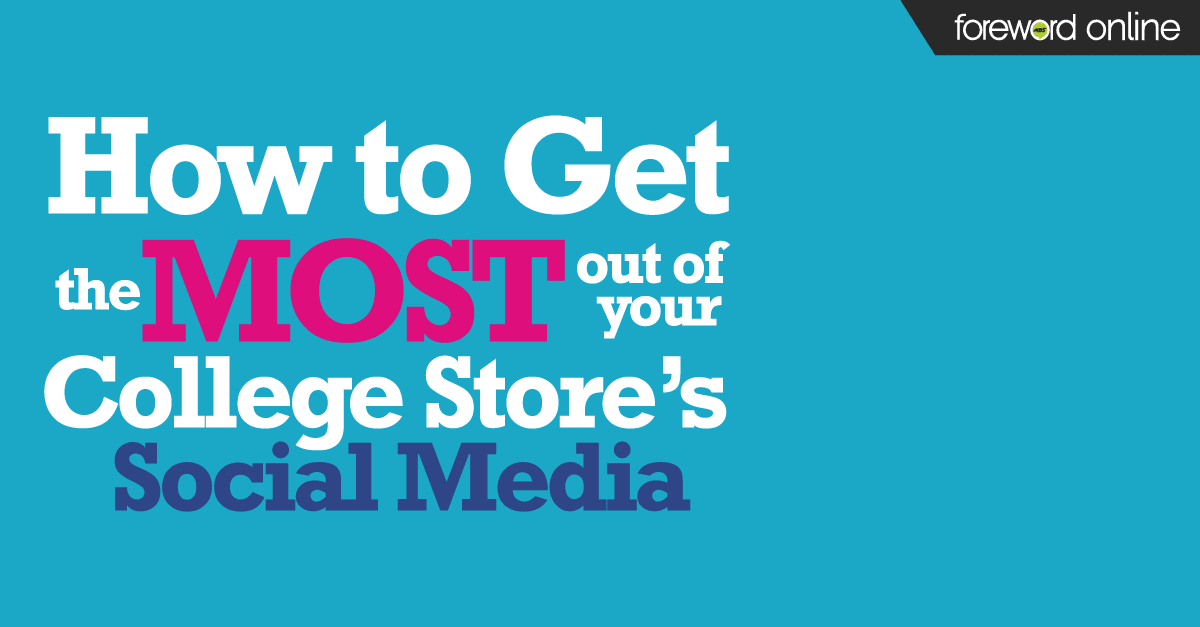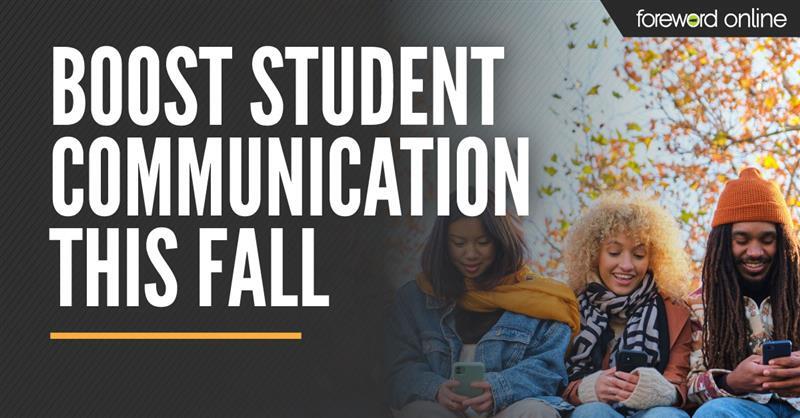Building a fanbase for your college store on social media isn’t as hard as you think. It boils down to knowing how the platforms work, understanding your audience and offering a variety of content. Once you master these elements, apply consistently. Your posts can experience what I call the web effect — a reach that expands as friends influence each other’s choices. Platform, audience and variety of posts impact your reach and audience influence. Let’s break down how each of these aspects can be utilized to increase the number of students who see your posts.
Increase your social media reach
We all know the basics. Twitter gives you 280 characters to share your thoughts. Instagram acts more like a picture-based blog. And Facebook is an enormous social networking site. Once you get past the basic structures of these platforms, they all work the same way: algorithms. Algorithms determine a post’s reach. With hundreds, maybe thousands, of potential pieces of content vying for position on a person’s timeline, the sites have to have a way of ranking the content and that’s why these algorithms were put in place.
If you enjoy a post, but don’t interact with it, the social media algorithm won't know you want to see similar content.
Therefore, once you master one platform a similar strategy can be used on all of them (except Snapchat which is just starting to implement algorithms). Algorithms work behind the scenes on these sites to determine what posts you see or do not see in your timeline. When that friend says she posted something on Facebook and you never saw it, chances are Facebook’s algorithms determined it wasn’t something you wanted to see.
Why is that?
The algorithm is only as smart as the interactions we have online. If you enjoy a post, but don’t interact with it, the social media algorithm won't know you want to see similar content. Posts that you like are given weight, however not as much as an emoji reaction or a share or a comment. Each method of interaction has a weight assigned to it that is used to determine the type of posts you want to see. The whole process is designed to make social media more fun for audiences, but it makes it harder for businesses to get their message out.
Facebook is probably the most famous for operating like this. People have too many friends and follow too many people, so there has to be an internal ranking system that makes sure you are actually seeing the content you want to see. As a result, organic reach isn’t what it used to be, but it is still possible to achieve. There are ways to teach the algorithm that your content matters. The more interactions a post gets, the more it is seen by others because the formula deems the content useful.
Therefore, your goal as a business is clear. You want people to engage with your posts because that will keep your message showing up in their timelines.
5 way to increase a college store's social media reach
- Post frequently
The more you post, the more chances people have to interact and the more value you are given in the algorithm. If I post on my Facebook business page three times a day, I have three different numbers for post engagement. One post might receive 9,000 impressions, one might receive 1,200 and the other could end up as low as 18. That’s why tracking what you post, when you post and how many interactions the post receives are important factors in determining how to increase reach. What was different about the post that had 9,000 impressions? How can that level of engagement be repeated? These answers provide solutions to increasing your organic reach. - Use hashtags
Hashtags are incredibly simple. They are a means by which to search. Twitter started the hashtag phenomenon, but it has spread to all platforms to varying degrees. Use hashtags that are relevant to what you are posting, are being used by others and will help you reach your customer base. With Instagram and Twitter, hashtags make you more discoverable. With Facebook, the audience does not typically use hashtags to follow subjects.
As a college store, always use your college’s hashtag on every post. This is a way students and alumni will find you. It is also a way you can find people in your own college to interact with. Let’s say you search your college’s hashtag and see someone wearing a shirt you sell in your store. Maybe comment: “I like your shirt. Show us this picture next time you come in for 15% off your next purchase.” Not only will the student get a kick you out of “the bookstore” seeing their post, but all of their friends will also see your comment. - Use emojis
I admit I cringe a little even as I type this. Emojis are not my chosen form of communication, but that isn’t true for everyone. To millennials and Generation Z, emojis are an important part of their lexicon — they are actually a preferred method of communication. They are so important, in fact, that Google, Facebook, Instagram and Twitter all have the ability to search by emoji now. Use emojis in your hashtag, but make sure you understand what the emoji stands for in the Gen Z lexicon. The important part is that you are speaking the students’ language.
my chosen form of communication, but that isn’t true for everyone. To millennials and Generation Z, emojis are an important part of their lexicon — they are actually a preferred method of communication. They are so important, in fact, that Google, Facebook, Instagram and Twitter all have the ability to search by emoji now. Use emojis in your hashtag, but make sure you understand what the emoji stands for in the Gen Z lexicon. The important part is that you are speaking the students’ language. - Offer a service
This point is key: you have to give students, or anyone, a reason to follow you. Whether they follow you for campus information, helpful advice or a weekly coupon, there needs to be a tangible reason for them to give you their time. Ask yourself what service you are providing. What are you posting and what benefit will it have to the person who is following you. Absolutely let people know when you are running specials in the store, but don't let it be the only type of posts you do. In fact, go with an 80/20 rule. 80% of your posts should not be related to sales, but should still directly offer benefit to your audience. Read how Danville Community College tackled their social media strategy. - Respond
Lead by example. If you want people to comment on your posts, then like their comments and reply back. Social media needs to be social. Starting a dialogue is a great way to accomplish that and to let your customers know you really do care about their opinions and their interaction with you. Plus, it helps make the store feel like a business composed of real human beings and not a nameless, faceless organization.
Take action: Set a goal to post three times a day and track your results for a month.
Where are your customers?
You know your students better than anyone. Everything you need to know to reach them on social media is at your fingertips. Why guess at what platforms they are on when you can simply ask them as they come into the store. Start that dialogue with students and use it to offer them a service they want through your social media efforts. Today we are going to discuss how to determine where to find your audience and how to make your page an asset to them.
In general, Facebook is the better choice for an older audience — not necessarily college students. However, your school might have a lot of non-traditional students, and that may be where they are. Or, maybe the majority are on Twitter or Instagram. It doesn’t matter, just make sure you go where they already are.
Why does this matter?
Apart from the obvious reason of having potential customers be able to follow you, you will reach more of their friends too. When your audience is actively engaged, you gain what I call the web effect. If a consumer sees something and they like it or comment on it, that action is visible on their friends’ timelines — an endorsement for your store by someone they trust. That friend, who might not even follow your page, has the new awareness that your page exists and can like or comment on the post as well, starting the reaction again. Much like grass-roots marketing campaigns, this direct digital word-of-mouth can carry a message farther and with more impact than a print advertisement. It is a form of influencer marketing.
Questions to ask about your college store social media
- What platform do students use?
Getting the answer to this is as easy as asking students informally or talking to your student employees. We all have our favorite social media platforms. Take direction from the students. Ask for their top three and keep an informal tally to give you an idea of what platform is most convenient for the majority of them. Also, inquire how often they check these platforms. Everyone might be on Facebook, but if they only check it once a month, it probably isn’t the best choice.
asking students informally or talking to your student employees. We all have our favorite social media platforms. Take direction from the students. Ask for their top three and keep an informal tally to give you an idea of what platform is most convenient for the majority of them. Also, inquire how often they check these platforms. Everyone might be on Facebook, but if they only check it once a month, it probably isn’t the best choice. - What do they want to see from you?
You want to fulfil students’ expectations. Get an idea of a couple different topics they would be interested in. This will give you a better idea of how to keep your fanbase engaged. Maybe they would like study tips, ways to save money, campus trivia or special offers. Whatever it is they are looking for, assess whether or not it is something your store can provide. - What information would be most useful for students to have?
If your school has a lot of nontraditional or first-generation students, they might not know what they don’t know. It has been shown that first-generation students pay more for their textbooks than any other group. Maybe offering information about the different options available to them and how they can better navigate college life would help build trust between the students and the store. Nontraditional and Gen Z students are highly career-minded, you might want to offer links to books and articles that offer great professional advice.
Take action: This week, develop a plan for how you and your employees will get to know your students as well as the types of information you can share with them.
Add variety to your social media posts
A variety of content is always a good idea. Offering a combination of images, links, videos and statuses is the best way to reach a broader market of students. Everyone likes different things on social media. I love memes that make me laugh; I stop to read all of them as I am scrolling through my feeds. However, I have friends who watch every video that comes through their feed. By offering a variety, everyone can find something on your page that interests them, which increases their chances of interacting.
6 ways to add variety
- Takeovers
Student or faculty takeovers are a great way to gain followers, grow interactions and save time. Social media can be consuming. There are ways to save time, but it still requires an investment. However, if you have a trusted employee, student or member of the faculty who already has a good social media following post for you for a week, not only will it provide wonderful content diversity, it will also give the account a fresh voice while letting you take a break. - Vibrant images
It doesn’t matter if you are on Instagram or Twitter, better pictures will get better interaction. Look for bold colors that will stand out on the screen. Try to frame the pictures you take to tell a story. The University of Edinburgh has a beautiful Instagram page worth following for inspiration. Its pictures are eye-catching, it hosts student takeovers and it expertly uses hashtags.
Also, keep an eye on the current battle for the smartphone camera. It’s an example of the development happening across platforms. The company that proves more successful, might become your students’ new favorite platform.
- Call to action posts
With Facebook’s latest changes to their algorithms, it is best to avoid asking for comments, likes or shares if you are trying to reach a larger audience with your college social media accounts. However, that doesn’t mean you can’t use a call to action to help engage the audience. For example, post four different t-shirt designs and ask the students to vote for the one they like best. These informal polls can be about anything. People love giving their opinion especially if it is a neutral topic and easy to do. It can be done through images or words; the responses are what’s important. This sort of post is a great way to build interactions and to keep your page on more timelines. Try to keep your inquiries visual and simple. - Humor
Don’t forget to be funny. Sharing a humorous meme is one of the easiest ways to get interactions or shares. Laughing is also a great stress release for students. Laughter soothes tension, and it can leave you feeling good and relaxed. Those positive emotions can then be associated with following your page.
is one of the easiest ways to get interactions or shares. Laughing is also a great stress release for students. Laughter soothes tension, and it can leave you feeling good and relaxed. Those positive emotions can then be associated with following your page. - Student ambassadors
Embrace body positivity and use students to help model your merchandise. People like to see images of people who look like themselves and students are no different. In fact, Generation Z is more influenced by YouTube personalities than traditional celebrities. Why? Because the people on YouTube aren’t polished. They are imperfect average people who are speaking directly to people who are like them. It’s a compelling connection. - Behind the scenes
Stocking new merchandise? Snap a picture and give people a sneak peek of what’s to come. Setting up for an event or having an employee meeting? Take a picture. As uninteresting as these events may seem to you, people love to know what happens behind the scenes. This insider knowledge can build excitement and inspire an active interest in your store. It also reminds people that the college store isn’t just a business; there are real people there.
Take action: Try at least one of each different type of content and make note of what response you get from your audience.
Embracing all three aspects — platforms, audience and content — can help you grow your social media accounts faster than ever, but don’t get too caught up in the idea of needing to grow fast. Having 10,000 fans who don’t care about what you are saying isn’t better than having 400 interested people. There are lots of easy ways to buy likes or clicks, but that doesn’t translate into sales. While it may be slow-going at times, it is better to plug away and do things right than to skip ahead. When people follow your store who don’t have an interest in what you are doing, they aren’t going to respond. Those uninterested followers make it harder to reach people who do care because the algorithms have no way to distinguish between the two groups.
Develop a strong platform. Post signs around the store letting people know why they should follow you (the promise of exclusive deals always works well) and follow through by offering your followers great content that keeps them connected to your store and school.






